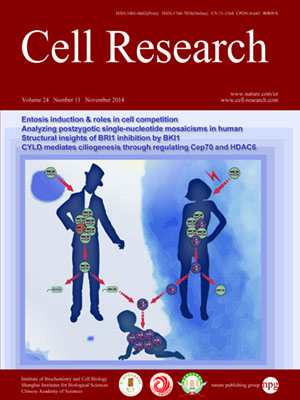
Volume 24, No 11, Nov 2014
ISSN: 1001-0602
EISSN: 1748-7838 2018
impact factor 17.848*
(Clarivate Analytics, 2019)
Volume 24 Issue 11, November 2014: 1342-1353
ORIGINAL ARTICLES
CYLD mediates ciliogenesis in multiple organs by deubiquitinating Cep70 and inactivating HDAC6
Yunfan Yang, Jie Ran, Min Liu, Dengwen Li, Yuanyuan Li, Xingjuan Shi, Dan Meng, Junmin Pan, Guangshuo Ou, Ritu Aneja, Shao-Cong Sun and Jun Zhou
Correspondence:
Cilia are hair-like organelles extending from the cell surface with important sensory and motility functions. Ciliary defects can result in a wide range of human diseases known as ciliopathies. However, the molecular mechanisms controlling ciliogenesis remain poorly defined. Here we show that cylindromatosis (CYLD), a tumor suppressor protein harboring deubiquitinase activity, plays a critical role in the assembly of both primary and motile cilia in multiple organs. CYLD knockout mice exhibit polydactyly and various ciliary defects, such as failure in basal body anchorage and disorganization of basal bodies and axenomes. The ciliary function of CYLD is partially attributed to its deconjugation of the polyubiquitin chain from centrosomal protein of 70 kDa (Cep70), a requirement for Cep70 to interact with γ-tubulin and localize at the centrosome. In addition, CYLD-mediated inhibition of histone deacetylase 6 (HDAC6), which promotes tubulin acetylation, constitutes another mechanism for the ciliary function of CYLD. Small-molecule inhibitors of HDAC6 could partially rescue the ciliary defects in CYLD knockout mice. These findings highlight the importance of protein ubiquitination in the modulation of ciliogenesis, identify CYLD as a crucial regulator of this process, and suggest the involvement of CYLD deficiency in ciliopathies.
10.1038/cr.2014.136
FULL TEXT | PDF
Browse 2251


